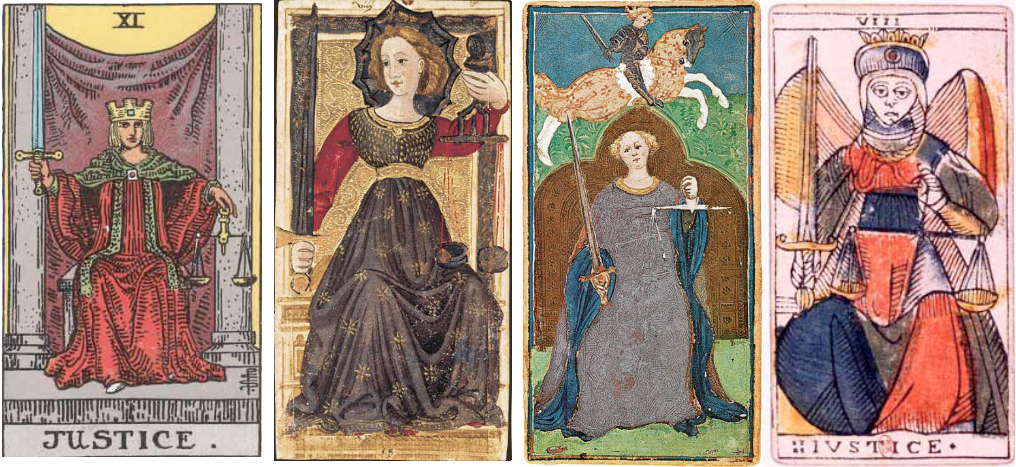Justice
Justice is the eleventh card in the Major Arcana in most traditional Tarot decks. In some decks, it is the eighth card.
It is associated with the qlippoth of Thaumiel ("Twins of God") on the Kabbalistic Tree of Death.
Depiction
In the Rider-Waite Tarot, artist Pamela Colman Smith portrays Justice as woman seen full face, and wearing an iron coronet, is seated upon a throne. She is placed between the two columns of the temple. The solar cross is traced upon her breast. The figure is seated between pillars, like The High Priestess, and on this account it seems to indicate the moral principle which deals unto every man according to his works differs in its essence from the spiritual justice which is involved in the idea of election.
From the earliest decks, beginning with the Visconti-Sforza Tarot, Justice has always been depicted as a blonde-haired woman holding a sword and a scale, but in the Italian decks, she was facing toward her right hand, the one holding the sword, indicating a "blindness" about how the scale in her other hand was being balanced. This reinforced the legal theory of justice being impartial and only seeking the truth of a matter.
At least as early at the Tarot of Marseilles, Justice began facing forward, looking directly at the viewer.
Symbolism
The woman holds a balance in her left hand. The left hand derives from, while the right hand is instrumental in giving out. Scorpio derives from Libra the balance and the idea of justice, but the sword in the right hand shows, that we have not justice pure and simple, platonic so to speak, but that which has often been called avenging justice. The sword here is a sign of protection for the good, as well as a menace for the bad. Therefore, it is more vengeance than justice in every way and every form. It is the card of sorrow as well as of deeper satisfaction. In the man under this card there is always something of the avenger of wrongs, and very often it has to do with the proceedings of justice in the world.
Every mistake in the process of life will avenge itself with geometrical certainty. Continued effort results in the establishment of an equilibrium, between the destruction of the works of man accomplished by nature, when left to herself, and the preservation of this work. Hence the idea of balancing power, and consequently of Justice attributed to this letter. This house is the school of life and in this house the Self takes from life and from the cosmos surrounding what it wants, consequently what it does not yet possess, and the card of Justice becomes the index for our debts or the possessions of other people.
So the card of Justice additionally indicates the faculty of desire, higher as well as lower, from the most spiritual or religious longing down to the most crude lust. Sexual experience is one of the most important expressions of it, and we may safely say, that one of the principal significances of the card is sex. Another, principally where sex is sublimated, is occult experience, and the psychical side of earth-life in general.
The female figure is said to be Astræa, who personified the same virtue and is represented by the same symbols. This goddess notwithstanding, and notwithstanding the vulgarian Cupid, the Tarot is not of Roman mythology, or of Greek either. Its presentation of justice is supposed to be one of the four cardinal virtues included in the sequence of the Major Arcana, but, as it so happens, the fourth emblem is wanting, and it became necessary for the commentators to discover it at all costs.
Card numbering
Justice is traditionally the eighth card, and Strength the eleventh, but the influential Rider–Waite Tarot switched the position of these two cards in order to make them better fit the astrological correspondences worked out by the Hermetic Order of the Golden Dawn, under which the eighth card is associated with Leo and the eleventh with Libra. This switch was originally suggested in the mysterious Cipher Manuscripts which formed the basis for the Golden Dawn's teachings regarding Tarot and other subjects. Today many divinatory tarot decks use this numbering, particularly in the English-speaking world.
Divinatory meaning
In divination, this card usually indicates equality, rightness, honesty, and integrity. Triumph in law.
In reversed position, it means: legal complications, bigotry, bias, or excessive severity.
| Tarot Topics | ||
|---|---|---|
| Major Arcana | The Fool • The Magician • The High Priestess • The Empress • The Emperor • The Hierophant • The Lovers • The Chariot • Strength • The Hermit • Wheel of Fortune • Justice • The Hanged Man • Death • Temperance • The Devil • The Tower • The Star • The Moon • The Sun • Judgement • The World | |
| Minor Arcana | Pentacles | Ace • Two • Three • Four • Five • Six • Seven • Eight • Nine • Ten • Page • Knight • Queen • King |
| Wands | Ace • Two • Three • Four • Five • Six • Seven • Eight • Nine • Ten • Page • Knight • Queen • King | |
| Cups | Ace • Two • Three • Four • Five • Six • Seven • Eight • Nine • Ten • Page • Knight • Queen • King | |
| Swords | Ace • Two • Three • Four • Five • Six • Seven • Eight • Nine • Ten • Page • Knight • Queen • King | |
| Decks | Visconti-Sforza Tarot • Tarot of Marseilles • Rider-Waite Tarot • Thoth Tarot • Occult Tarot • Angel Tarot • Vlad Dracula Tarot • Hieronymus Bosch Tarot | |
